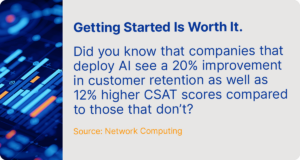If you’re feeling unprepared for the impact of generative artificial intelligence (GenAI), you’re not alone. In fact, nearly 85% of CX leaders feel the same way. But the truth is that the transformative nature of this technology simply can’t be ignored — and neither can your boss, who asked you to look into it.
We’ve all heard horror stories of racist chatbots and massive data leaks ruining brands’ reputations. But we’ve also seen statistics around the massive time and cost savings brands can achieve by offloading customers’ frequently asked questions to AI Assistants. So which is it?
This is the first post in a three-part series clarifying the biggest misconceptions holding CX leaders like you back from integrating GenAI into their CX strategies. Our goal? To assuage your fears and help you start getting real about adding an AI Assistant to your contact center — all in a fun “two truths and a lie” format. Prepare to have your most common AI misconceptions debunked!
Misconception #1: “My data isn’t good enough for GenAI.”
Answering customer inquiries usually requires two types of data:
- Knowledge (e.g. an order return policy) and
- Information from internal systems (e.g. the specific details of an order).
It’s easy to get caught up in overthinking the impact of data quality on AI performance and wondering whether or not your knowledge is even good enough to make an AI Assistant useful for your customers.
Updating hundreds of help desk articles is no small task, let alone building an entire knowledge base from scratch. Many CX leaders are worried about the amount of work it will require to clean up their data and whether their team has enough resources to support a GenAI initiative. In order for GenAI to be as effective as a human agent, it needs the same level of access to internal systems as human agents.
Truth #1: You have to have some amount of data.
Data is necessary to make AI work — there’s no way around it. You must provide some data for the model to access in order to generate answers. This is one of the most basic AI performance factors.
But we have good news: You need a lot less data than you think.
One of the most common myths about AI and data in CX is that it’s necessary to answer every possible customer question. Instead, focus on ensuring you have the knowledge necessary to answer your most frequently asked questions. This small step forward will have a major impact for your team without requiring a ton of time and resources to get started

Truth #2: Quality matters more than quantity.
Given the importance of relevant data in AI, a few succinct paragraphs of accurate information is better than volumes of outdated or conflicting documentation. But even then, don’t sweat the small stuff.
For example, did a product name change fail to make its way through half of your help desk articles? Are there unnecessary hyperlinks scattered throughout? Was it written for live agents versus customers?
No problem — the right Conversational CX Platform can easily address these AI data dependency concerns without requiring additional support from your team.
The Lie: Your data has to be perfectly unified and specifically formatted to train an AI Assistant.
Don’t worry if your data isn’t well-organized or perfectly formatted. The reality is that most companies have services and support materials scattered across websites, knowledge bases, PDFs, .csvs, and dozens of other places — and that’s okay!
Today, the tools and technology exist to make aggregating this fragmented data a breeze. They’re then able to cleanse and format it in a way that makes sense for a large language model (LLM) to use.
For example if you have an agent training manual in Google Docs and a product manual in PDF, this information can be disassembled, reformatted, and rewritten by an AI-powered transformation that makes it subsequently usable.
What’s more, the data used by your AI Assistant should be consistent with the data you use to train your human agents. This means that not only is it not required to build a special repository of information for your AI Assistant to learn from, but it’s not recommended. The very best AI platforms take on the work of maintaining this continuity by automatically processing and formatting new information for your Assistant as it’s published, as well as removing any information that’s been deleted.
Put Those Data Doubts to Bed
Now you know that your data is definitely good enough for GenAI to work for your business. Yes, quality matters more than quantity, but it doesn’t have to be perfect.
The technology exists to unify and format your data so that it’s usable by an LLM. And providing knowledge around even a handful of frequently asked questions can give your team a major lift right out the gate.
Keep an eye out for the next blog in our series, all about GenAI hallucinations. Or, learn the truth about all three of CX leaders’ biggest GenAI misconceptions now when you download our guide, Two Truths and a Lie: Breaking Down the Major GenAI Misconceptions Holding CX Leaders Back.



